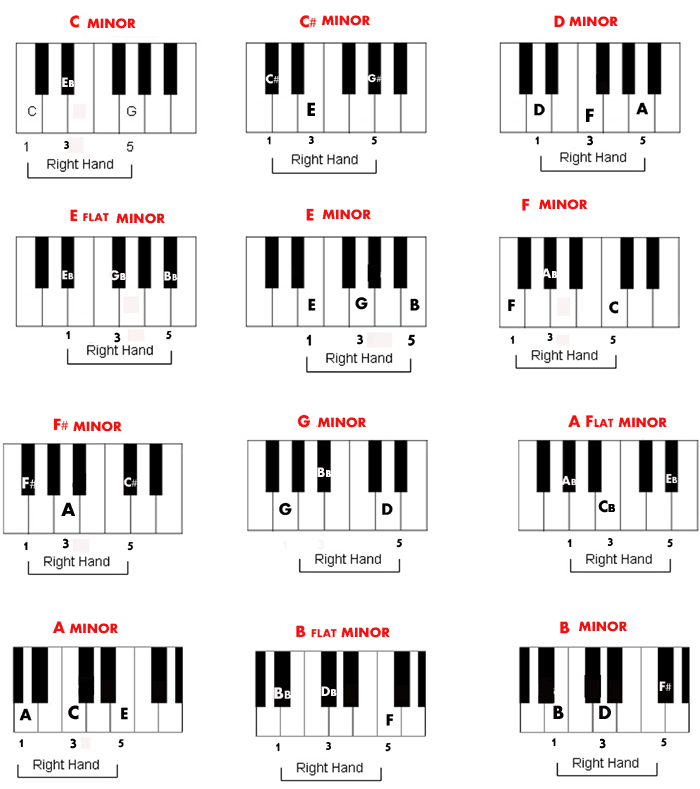
The scale contains two tritones, and its chords are richly dark and strange. Melodic minor gives the same major-minor seventh chord as harmonic minor.

Arpeggiating this chord gives a distinctive uneasy feeling that would sound great in an Alfred Hitchcock movie. The seventh chord you get from harmonic minor is called the minor-major seventh chord, and as the name suggests, it has an ambivalent feeling. Combining D minor and C minor chords gives a distinctive Dorian sound nicknamed the “ So What” riff. The uppermost three extensions to the C Dorian chord form a D minor triad. The seventh, ninth and eleventh of a C natural minor chord form a B-flat major triad. Usually you don’t extend natural minor chords past the eleventh, so the chord symbol for the thirteenth chord is not a standard one. In C, there is a minor third between C and E-flat. This interval is called a minor third, and it appears in all minor chords. Minor scales have three semitones (piano keys) between their first and third degrees. These are nice chords to use over a C root to create a suspended feeling in your minor key dominant chord. D-flat major and B-flat minor are both subdominant chords in the key of F minor. The top four form a B-flat minor seventh chord. Notice also that the top three extensions form a D-flat major triad. If you ignore the root, the rest of the notes form an E diminished chord. Like Mixolydian, Phrygian dominant can also stand on its own, creating a strongly Middle Eastern or Jewish feel. The dominant seventh flat ninth chord defines minor keys. Phrygian dominant is the minor-key equivalent of Mixolydian. The Lydian dominant mode has two tritones in it, so the chords it produces are exotic and modern-sounding. Any time you have a major chord that isn’t the tonic, try putting sharp eleventh in it. They sound terrific together, giving a smooth and creamy sound. Unlike the major scale, Lydian has no clash between its third and fourth scale degrees. In blues, rock, and jazz, dominant seventh chords can act as home base. In more modern music, tritones need not resolve at all. The sound of the tritone resolving to a “nicer” interval is the structural basis of all Western tonal harmony. The interval between the dominant seventh chord’s third and seventh is called a tritone. The chord combining a major third with a flat seventh is called a dominant seventh chord. Of course, if you want some dissonance, by all means, use both. The chords aren’t all smooth and consonant, though the fourth clashes with the third, so if you’re going to make a major eleventh chord, typically you’d leave the third out. The major scale is the plain vanilla of the European-descended harmonic universe. In C, there’s a major third between C and E. This interval is called a major third, and it appears in all major chords. Major scales have four semitones (piano keys) between their first and third degrees. Hear extended chords built from a variety of scales: You’ve now used every possible note in your chord. The next third after the thirteenth is just the root of the scale.Finally, you arrive at the thirteenth note of the scale, which is the sixth note an octave up.Then you come to the eleventh note of the scale, which is the fourth note an octave up.Next you come to the ninth note of the scale, which is really just the second note an octave up.If you add the seventh scale degree on top, you get a seventh chord.If you start on the first scale degree, add the third scale degree, and then add the fifth scale degree, you get a simple three-note chord called a triad.To get more notes for your chord, just keep adding thirds on top. To make a chord, you start on the first note of a scale and then move up it in thirds, meaning that you skip every alternating note. And here’s a guide to the most commonly-used chords. Here’s a guide to some of the most commonly-used scales in Western music and their moods. If you stack them up and play them simultaneously, you get chords. If you organize the pitches sequentially and play them one at a time, you get a scale. Jazz musicians think of chords and scales as two different ways of looking at the same thing: a group of pitches that sound good together.


 0 kommentar(er)
0 kommentar(er)
